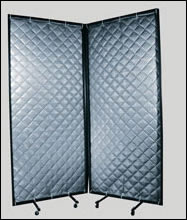My girlfriend works for a current affairs magazine here in the UK, and one of her responsibilities there is to produce and edit their podcast. She's a journalist, not an audio person, so, understandably, she gets mixed results. The magazine don't want to spend very much money on the podcast, so it's just recorded in one of the conference rooms of their offices on £50 mics.
They've recently moved offices and the sound in the new recording place is (you can listen to the show here, episode #107 is particularly problematic) quite terrible. So I said I'd try and get some tips for her on how she can improve the recording quality.
I'd appreciate any advice that can be given. The magazine won't pay for new microphones or anything like that, so it's just practical tips about what can be done to soften the recording environment, or to control the recording. She has a hundred other jobs at the magazine, so the show has to be recorded and edited really quickly, and they'd never consider getting in a dedicated professional to do it – so that's the basic context of my question.
Extra info: the mics are 3 Behringer C3, the recorder is a Zoom (not sure which but probably lower end than H4N), and she's not sure what the Mixer is. Not a lot to go on, I know! The show is edited in Audacity, and the magazine won't pay for better software.
(I know that the moral of this story is that publications should take sound quality more seriously with their productions, but, putting that aside, anything that can help her make the show sound better would be much appreciated!)
They've recently moved offices and the sound in the new recording place is (you can listen to the show here, episode #107 is particularly problematic) quite terrible. So I said I'd try and get some tips for her on how she can improve the recording quality.
I'd appreciate any advice that can be given. The magazine won't pay for new microphones or anything like that, so it's just practical tips about what can be done to soften the recording environment, or to control the recording. She has a hundred other jobs at the magazine, so the show has to be recorded and edited really quickly, and they'd never consider getting in a dedicated professional to do it – so that's the basic context of my question.
Extra info: the mics are 3 Behringer C3, the recorder is a Zoom (not sure which but probably lower end than H4N), and she's not sure what the Mixer is. Not a lot to go on, I know! The show is edited in Audacity, and the magazine won't pay for better software.
(I know that the moral of this story is that publications should take sound quality more seriously with their productions, but, putting that aside, anything that can help her make the show sound better would be much appreciated!)





